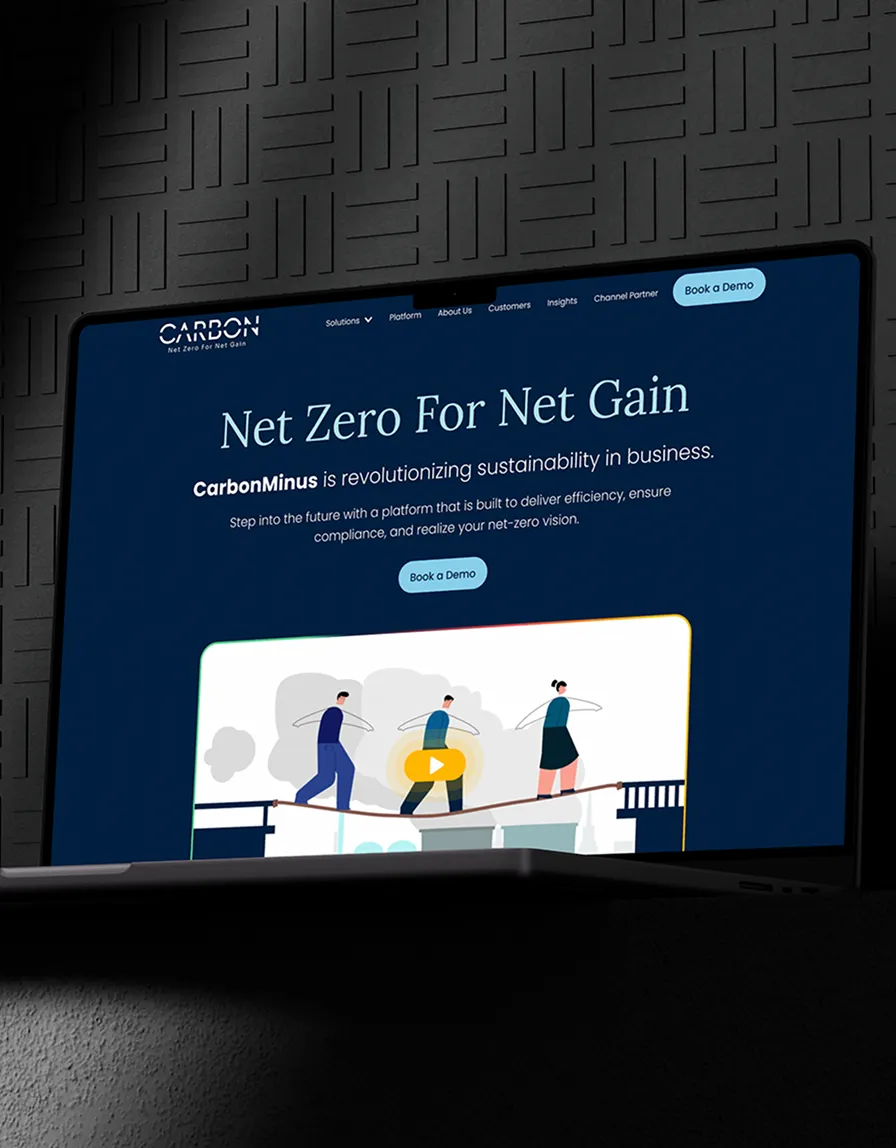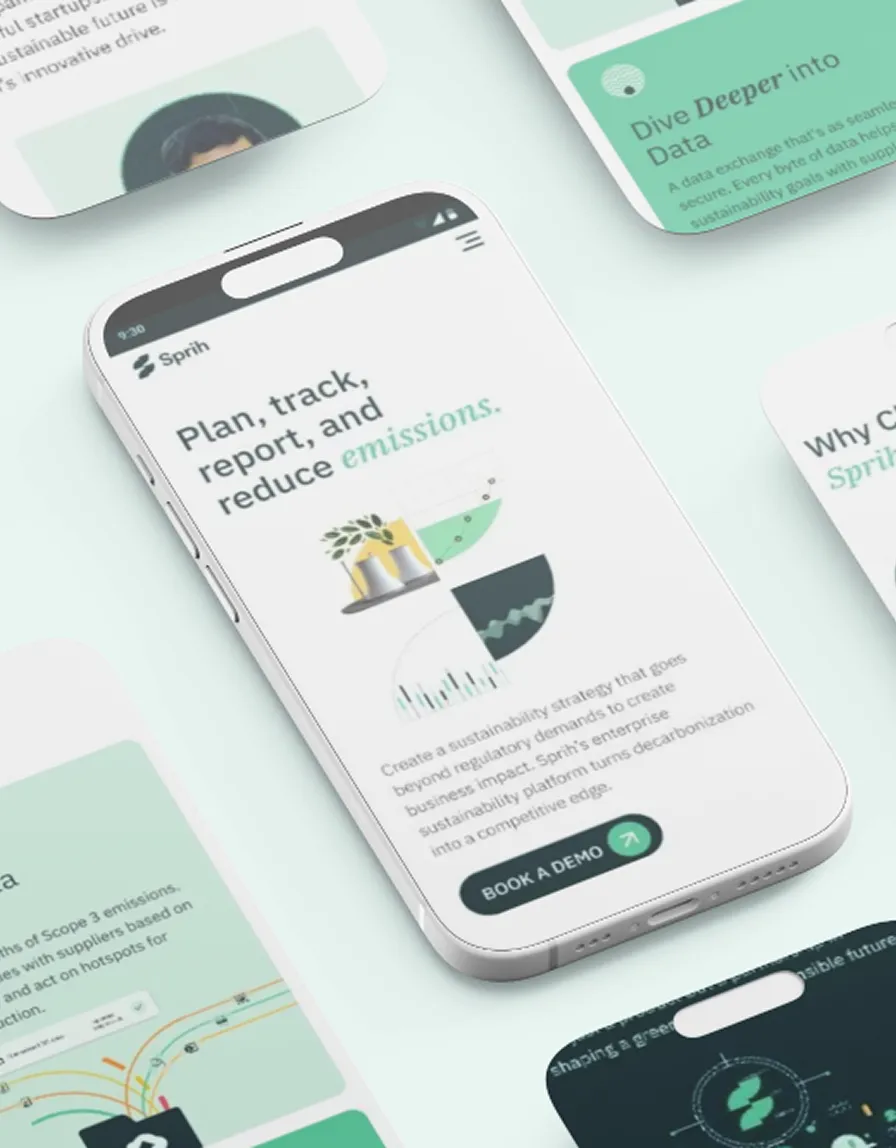But to scale the mission, the messaging needs to scale too.












































































































































Articulate market shifts in plain language
Win commercial pilots without diluting the vision
Design category narratives that align tech, policy, and public good
Balance infrastructure-grade credibility with startup-grade agility
Messaging caught between engineering-speak and NGO-speak
Websites that explain features, not outcomes
Funding decks that work—but go-to-market that lags
Struggle to position against legacy giants and greenwashing clones
Category creation rooted in net-zero economics. Multi-stakeholder narrative design (investor, partner, policymaker). Climate-specific segmentation and strategic messaging. Language systems to shift the Overton window.
Conversion UX for pilot programs, partnerships, and grant funnels. Technical validation + emotional clarity in one journey. Interactive demos, data explorers, and lifecycle maps. Web platforms optimized for due diligence and public narrative
CRM architecture for long-cycle climate deals. Cross-sector nurture paths: enterprise, government, community. Stakeholder-specific engagement scoring. Grant, pilot, and PPA-based sales enablement tooling
Thought leadership built on policy fluency and systems design. Analyst-grade content for institutional buyers. Movement marketing for mission-aligned adoption. Climate category leadership playbooks (not performance-marketing fluff)







You’re not here to go viral. You’re here to hit grid parity. To shift regulatory incentives. To transition the built environment. And to do that, you need a story that earns trust—at scale.
We help climate tech, energy platforms, and sustainability ventures move from proof of concept to proof of category.


Anchor your story in public-private-commercial alignment
Create messaging fluency across scientists, suppliers, and senators
Shift stakeholder narratives from policy to infrastructure to people

Build growth models that account for policy tailwinds and lagging regulation
Design incentives that drive early partner adoption
Prototype multi-revenue stream storytelling (carbon, credits, kilowatts)

UX + brand that mirrors operational maturity
Platforms that function as ecosystem command centers
Frictionless onboarding for buyers, backers, builders

Third-party validation content (MOUs, pilots, field trials)
Climate transparency UX that preempts scrutiny
Messaging for credibility at every scale stage

Co-marketing with climate coalitions and ecosystem players
Analyst briefings, movement partners, and academic validators
IP-led demand, not discount-driven acquisition

Segment by behavioral readiness, not just firmographics
Create nurture paths aligned to funding + regulatory timelines
Enterprise + civic sales content that wins non-obvious champions

CRM systems tuned to grants, utility deals, and offtake agreements
Attribution models for pilot-to-platform journeys
Martech built for conviction-led growth, not just clicks













Effective climate tech positioning bridges the gap between technical innovation and market-ready narratives. The key is developing a multi-layered messaging architecture:
· Technical validation for engineers and scientists
· Commercial outcomes for enterprise buyers
· System-level impact for policymakers and investors
· Tangible benefits for end-users and communities
The most successful approach avoids both overly technical jargon and vague sustainability claims. Instead, focus on articulating specifically how your technology enables concrete decarbonization pathways, creates economic advantages, and fits within existing infrastructure systems. This balanced positioning helps you speak credibly to technical evaluators while making your innovation accessible to financial decision-makers.
Climate tech commercialization follows fundamentally different dynamics than conventional tech GTM:
· Longer sales cycles influenced by regulatory timelines and infrastructure planning
· Multi-stakeholder buying committees spanning technical, financial, and sustainability functions
· Blended revenue models combining traditional sales with grants, incentives, and carbon markets
· Higher validation requirements reflecting the mission-critical nature of infrastructure technology
The most effective approach builds specialized funnels for each stakeholder group while maintaining consistent core messaging about your solution's role in the broader transition. Unlike traditional tech that can focus purely on product-market fit, climate tech requires simultaneous "product-market-policy fit" to navigate the complex landscape of incentives, regulations, and market signals.
Beyond traditional marketing KPIs, sophisticated climate tech companies track:
· Ecosystem influence metrics (policy citations, industry standards adoption)
· Stakeholder diversification (balance across corporate, government, and financial engagement)
· Technical validation momentum (pilot conversions, field trial results)
· Category ownership indicators (share of voice in specific decarbonization pathways)
While conversion metrics remain important, the most valuable climate tech marketing dashboards connect these indicators to commercialization milestones and market transformation goals. This approach recognizes that success often depends on shifting entire systems, not just individual purchasing decisions.
Technical depth is essential for credibility, but can create barriers to broader understanding. The most effective approach:
· Develops tiered messaging for different technical literacy levels
· Uses visual systems to convey complex concepts without simplifying the science
· Creates comparative frameworks that position your innovation against known alternatives
· Focuses on outcomes and use cases before diving into technological explanations
The most successful climate tech companies create what we call "progressive disclosure" architectures—allowing audiences to self-select their technical depth while ensuring
everyone understands the fundamental value proposition. This balanced approach maintains scientific integrity while making your innovation accessible to non-technical stakeholders.
Rather than treating mission and commercial elements as competing priorities, integrate them through strategic positioning:
· Frame your technology as the practical implementation of your mission, not separate from it
· Position economic benefits as accelerants of climate impact, not trade-offs
· Develop messaging that connects immediate business outcomes to longer-term system change
· Use quantitative impact metrics that demonstrate both commercial and environmental value
The most effective approach recognizes that in climate tech, mission alignment often enhances commercial credibility rather than diminishing it. By demonstrating how your solution creates tangible business advantages through decarbonization, you can appeal to pragmatic buyers while staying true to your core purpose.
Policy engagement requires specialized marketing strategies:
· Develop evidence-based content that translates your technology's impact into policy-relevant metrics
· Create frameworks connecting your innovation to specific regulatory goals and compliance pathways
· Build coalition-based thought leadership with industry associations and research institutions
· Develop case studies demonstrating real-world implementation of policy objectives
The most sophisticated approach positions your solution as an enabler of policy goals rather than a beneficiary of incentives. This subtle shift builds credibility with policymakers
by demonstrating how your technology can help achieve regulatory objectives, creating mutually beneficial relationships rather than transactional ones.
For many climate technology companies, category creation isn't just a marketing strategy—it's a commercial necessity:
· New categories can avoid direct competition with established but less efficient approaches
· Well-defined categories help educate the market about novel technological approaches
· Category leadership positions you to influence developing standards and regulations
· Distinct categories can attract specialized investment and partnership opportunities
The most effective category creation doesn't just differentiate your company—it reshapes how the market thinks about solving specific decarbonization challenges. By establishing the criteria by which solutions should be evaluated, you can create favorable conditions for your approach while accelerating system-level change.
Early-stage validation requires creative approaches to credibility-building:
· Focus on specific technical milestones and performance metrics from limited deployments
· Develop comparative analyses against theoretical alternatives or industry benchmarks
· Showcase partnership quality through joint development narratives
· Create scenario-based modeling validated by third-party experts
The most successful approach balances transparency about your current stage with confidence in your trajectory. By setting clear expectations while providing concrete evidence of progress, you can build trust with stakeholders while your commercial momentum develops.
Effective climate tech content breaks from conventional B2B content formulas:
· Develop authoritative, data-rich technical content that establishes fundamental credibility
· Create frameworks explaining how your technology fits within broader system transformation
· Build educational content about your specific decarbonization pathway
· Develop decision-maker content addressing economic and implementation considerations
The most sophisticated approach creates content ecosystems rather than isolated assets—building interconnected narratives that guide stakeholders from system understanding through technology evaluation to implementation planning. This comprehensive approach supports complex, multi-stakeholder decisions that characterize climate technology adoption.
Shifting the ROI conversation requires sophisticated value communication:
· Develop total value of ownership models rather than simple payback calculations
· Create risk-adjusted analyses incorporating regulatory trends and market evolution
· Build comparative frameworks showing advantages over status quo technologies
· Design scenario planning tools that demonstrate long-term economic advantages
The most effective approach goes beyond traditional ROI to incorporate risk mitigation, resilience benefits, and strategic positioning advantages. By expanding the conversation beyond immediate financial returns, you can create more favorable evaluation frameworks for technologies with systemic benefits that accrue over longer timeframes.
These stakeholders operate with fundamentally different priorities requiring tailored approaches:
Sustainability Leaders:
· Focus on alignment with corporate ESG commitments and reporting frameworks
· Develop content connecting your solution to specific sustainability metrics and frameworks
· Create implementation roadmaps aligned with published climate commitments
Infrastructure Decision-Makers:
· Emphasize operational reliability, integration pathways, and technical compatibility
· Develop content focused on risk mitigation and system performance
· Create technical validation materials addressing implementation concerns
The most effective strategy recognizes that these stakeholders often participate in the same decision process with different priorities. Developing stakeholder-specific content while maintaining consistent core messaging allows you to address diverse concerns while building cohesive support for your solution.
Technical thought leadership serves multiple critical functions beyond brand building:
· Establishes foundational credibility with technical evaluators and scientific communities
· Creates opportunities for partnership development with research institutions and industry leaders
· Positions your team as forward-thinking experts capable of addressing emerging challenges
· Builds intellectual property that strengthens both marketing and commercial positioning
The most valuable approach focuses on developing distinct perspectives on industry evolution rather than simply demonstrating technical competence. By articulating insights about where systems are heading—and how your technology addresses these trajectories—you can shift from participant to leader in industry conversations.
Credible impact communication requires methodological rigor and appropriate qualification:
· Develop transparent, methodology-based impact calculations with clear assumptions
· Use comparative frameworks that show relative improvements over specific alternatives
· Focus on direct, measurable impacts rather than speculative or indirect effects
· Provide appropriate context about implementation requirements and limitations
The most respected approach combines quantitative precision with appropriate humility—making specific, defensible claims rather than sweeping statements. This balanced communication builds trust with sophisticated stakeholders while differentiating your solution from less rigorous competitors.
As climate tech companies scale, marketing must evolve through distinct phases:
· Technical validation (proving the science works): Focus on research partnerships, technical content, and expert validation
· Commercial validation (proving the business works): Develop case studies, ROI frameworks, and implementation guidance
· Scale validation (proving the impact works): Create ecosystem content, policy alignment narratives, and market transformation stories
Each phase requires different messaging priorities, content types, and stakeholder engagement strategies. The most successful transitions maintain technical credibility while progressively expanding commercial narratives, ensuring continuity while adapting to new market requirements.
Strategic partnerships provide unique marketing advantages for climate tech companies:
· Validation through association with established industry players
· Access to specialized channels and buying committees
· Technical credibility through integration with existing systems
· Implementation capacity that addresses scale concerns
The most effective partnership marketing goes beyond logo displays to tell cohesive stories about how complementary capabilities create complete solutions. This ecosystem-based approach addresses the interconnected nature of climate challenges while building confidence in your ability to deliver complex implementations.
Beyond reviewing portfolios, assess these critical factors:
· Technical fluency in your specific decarbonization pathway and technology approach
· Understanding of the regulatory landscape and policy drivers affecting your market
· Experience with multi-stakeholder marketing across corporate, government, and financial audiences
· Ability to translate complex innovation into compelling commercial narratives
· Track record helping similar companies navigate growth transitions
The ideal partner demonstrates both technical understanding and commercial marketing expertise—avoiding both overly technical approaches that fail to drive adoption and superficial messaging that undermines credibility with sophisticated stakeholders.
Establishing credibility for novel approaches requires strategic evidence-building:
· Develop rigorous technical validation with recognized third-party experts
· Create transparent methodology documentation that invites scrutiny
· Build progressive demonstration pathways showing evolution from concept to implementation
· Leverage advisory relationships with respected industry figures and institutions
The most effective approach directly addresses skepticism through methodical evidence development rather than attempting to bypass it. By demonstrating both technical rigor and appropriate caution about claims, you build sustainable trust that supports long-term relationships rather than short-term attention.
Multi-stakeholder messaging requires architectural rather than linear approaches:
· Create modular messaging frameworks with consistent core positioning
· Develop stakeholder-specific value narratives addressing diverse priorities
· Build interconnected content systems that allow various entry points
· Design clear information pathways that guide each audience through relevant aspects
The most sophisticated approach creates messaging matrices that maintain consistency while addressing the specific concerns of technical evaluators, financial decision-makers, sustainability leaders, and implementation teams. This architectural approach ensures coherent positioning while allowing stakeholders to engage with the aspects most relevant to their roles.
Community relationships serve multiple essential functions in climate tech commercialization:
· Implementation validation through local acceptance and participation
· Feedback loops that improve solution design and deployment
· Authentic storytelling that demonstrates real-world impact
· Advocacy networks that support broader adoption
The most effective approach views communities as partners rather than audiences—creating collaborative engagement models that build mutual value. This relationship-based perspective not only enhances local implementation success but also creates powerful narratives that resonate with other stakeholders seeking evidence of real-world impact.

